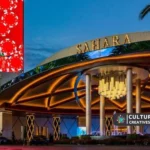The Sto. Niño Festival is a vibrant, religious celebration in the Philippines. It honors the Child Jesus, known as Santo Niño, with colorful parades and cultural dances. Each January, the Sto. Niño Festival transforms the streets of Cebu and other Filipino cities into a sprawling canvas of devotion and tradition. Devotees from across the archipelago converge to participate in ritual dances, flaunting elaborate costumes and heartfelt prayers.
The Sinulog Festival in Cebu is particularly famous, marked by the rhythmic two-steps-forward, one-step-back dance, symbolizing the flowing waters of the region’s Pahina River. This grand fiesta reflects the Catholic faith fused with indigenous practices, showcasing the Philippines’ rich cultural tapestry. The enthusiasm of the festival not only strengthens religious faith but also boosts tourism, inviting visitors worldwide to witness this mesmerizing blend of history, culture, and spirituality.
The Significance Of The Sto. Niño In Filipino Culture
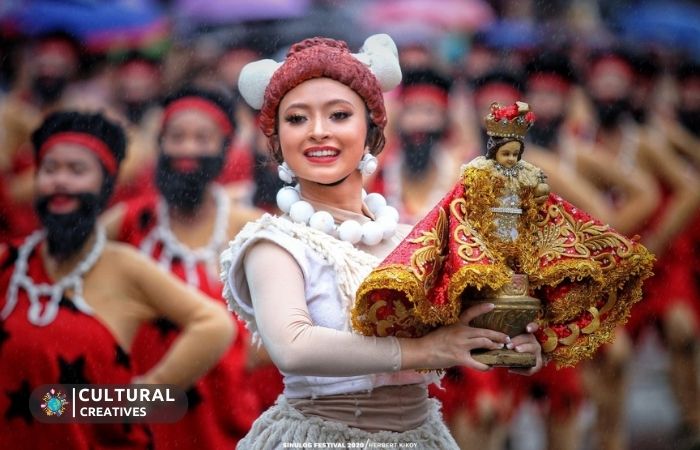
The devotion to the Sto. Niño holds a special place in the hearts of Filipinos. This venerated image represents not only the infancy of Jesus Christ but also symbolizes the birth of Christianity in the Philippines. Revered across the nation, the Sto. Niño embodies the Filipinos’ deep faith, resilience, and the joyful spirit that pervades their lives. Festivities dedicated to the Sto. Niño are celebrated with a zealous blend of religious fervor and cultural pageantry, showcasing the syncretism of pre-colonial traditions and Spanish-influenced Catholicism.
The Festival’s History And Evolution
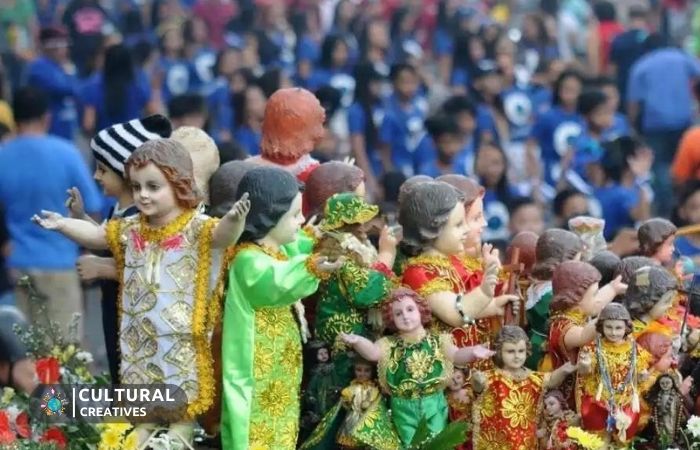
Tracing its roots back to the Spanish colonial era, the Sto. Niño Festival has evolved from its humble beginnings into a kaleidoscope of nationwide festivities. One of the most prominent celebrations occurs in Cebu City, known as the Sinulog Festival, which commemorates the Filipinos’ acceptance of Christianity and their reverence for the Sto. Niño. Over the centuries, the festival has grown to include a series of events such as grand parades, colorful dance competitions, and elaborate feasts. Each region in the Philippines has developed its own unique version of the festival, infused with local customs and traditions, yet all of them echo the same sentiment of love and homage to the Sto. Niño.
Whether you are a devout follower or a curious traveler, the festival is a captivating example of the Philippines’ rich cultural heritage. Through displays, joyous celebrations, and communal gatherings, Filipinos pay homage to the Sto. Niño, a figure that has shaped the cultural and spiritual landscapes of an entire nation.
The Festivity Breakdown: When And Where
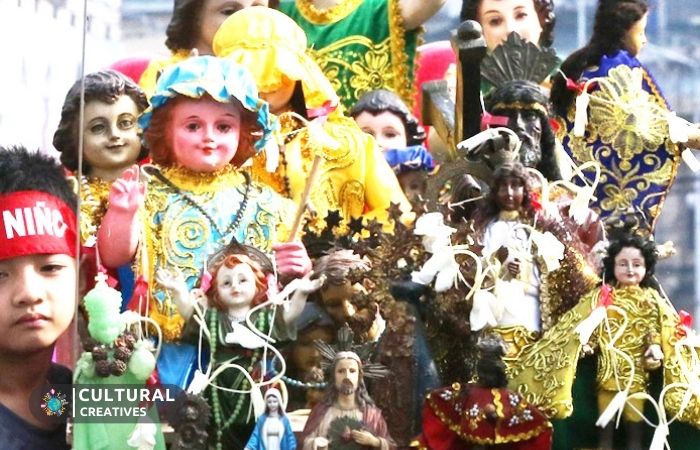
The Sto. Niño Festival is a tapestry of cultural riches, religious fervor, and unbridled joy. Every year, this festival turns streets into a kaleidoscope of colors, dance, and music, honoring the Holy Child Jesus, known as Sto. Niño. The exact dates and locations are pivotal for anyone hoping to immerse themselves fully in this extraordinary event.
Annual Schedule: Dates And Season
Timed to echo the Sinulog celebrations in Cebu, this feast is traditionally observed on the third Sunday of January. The festivities, however, build up days before the main event, creating a season of anticipation.
- Pre-festival activities: One week before the main event
- Main Festival Day: Third Sunday of January
- Post-festival events: Vary between regions
Geographical Heart Of The Celebration: Key Locations
While the Sto. Niño Festival is a nationwide celebration in the Philippines, certain areas are particularly renowned for their exuberant commemorations.
| Location | Notable Event |
|---|---|
| Cebu City | Grand Sinulog Festival – a religious and cultural festival with a grand street parade. |
| Iloilo City | Dinagyang Festival – known for its Ati-Atihan street dance competition and colorful face paintings. |
| Kalibo, Aklan | Ati-Atihan Festival – features both religious processions and merry-making in the streets. |
Each location has its unique flavor of celebration but shares a common thread of devotion to the Sto. Niño. Engage with the locals, join the processions, and absorb the spectacle that defines the cultural heart of the Philippines.
Spiritual Essence Of The Celebration

The Spiritual Essence of the festival transcends mere celebration; it’s a profound cultural and religious event that holds a special place in the hearts of its participants. The festival venerates the Holy Child Jesus, also known as Sto. Niño, reflecting a remarkable fusion of Christian and indigenous Filipino traditions. This blend of faith and culture is deeply manifested through various religious ceremonies and the symbolism of the Sto. Niño icon, which both play pivotal roles in the spiritual journey of the Filipino people during this fiesta.
Religious Ceremonies And Rituals
The festival is steeped in religious significance, featuring a mosaic of ceremonies and rituals that emphasize devotion and community spirit. The festivities commence with a series of Novena masses, which are a time for prayer, reflection, and preparation for the main event. Each mass draws in thousands of faithful, their voices in unison expressing earnest supplication and thanksgiving to the child Jesus.
- Fluvial Processions: A maritime tribute to the Sto. Niño, where a statue of the child Jesus sails along the river surrounded by a flotilla of decorated boats, with devotees following along the banks serenading and praising.
- Street Dancing: Participants adorned in colorful, elaborate costumes dance to the rhythmic beats of drums, their movements infused with religious intent, symbolizing stories of faith, gratitude, and petitions for blessings.
- Reenactments of Historical Events: Dramatic portrayals of events such as the Christianization of the Philippines demonstrate the deep-rootedness of the Sto. Niño in Filipino spirituality.
These rituals exemplify the unyielding faith and expression of worship within the community, capturing the very essence of what the Sto. Niño Festival signifies to believers.
The Sto. Niño Icon And Its Symbolism
Central to the festival is the venerated image of Sto. Niño, a representation that holds immense religious and cultural symbolism. This revered icon is not merely an artistic depiction but a symbolic embodiment of Jesus as protector and patron of the Filipino people.
| Feature | Symbolism |
|---|---|
| Regal Attire | Signifies kingship and divine authority |
| Scepter | Represents righteous rule and justice |
| Globus Cruciger | Embodies Christ’s dominion over the world |
| The Red Garment | Symbolizes the blood of Christ and his sacrifice |
Each aspect of the icon, from the crown on his head to the orb in his hand, is infused with meaning and contributes to an understanding of the divine nature of the child Jesus as both a monarch and a guardian.
Encapsulating both hope and reverence, the Sto. Niño icon plays a fundamental role in festival practices, instilling a sense of spiritual unity and purpose within the community. It is a constant reminder of the nation’s heritage and an enduring symbol of faith that has spanned centuries, enduring as a touchstone of Filipino spirituality.
Spectacular Events And Activities
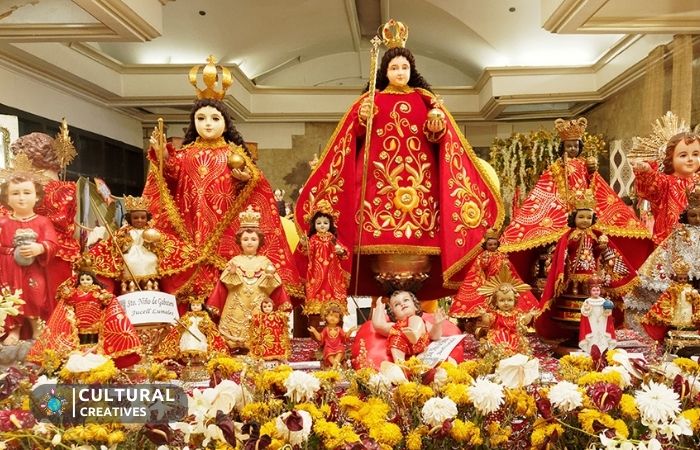
The Sto. Niño Festival, a tapestry of culture and faith, enthralls visitors with an array of spectacular events and activities. Annually, the streets come alive with exhilarating sounds, mesmerizing dances, and a burst of colors as the community honors the Holy Child Jesus. This jubilant occasion blends religious solemnity with euphoric celebration, captivating all who participate in its storied traditions.
Parade Of Colorful Costumes And Floats
The parade stands as a centerpiece of the festival, boasting an incredible display of creativity and craftsmanship. Participants don ornate costumes, each more intricate and dazzling than the last. These ensembles are complemented by stunning floats that illustrate scenes from the life of the Sto. Niño or depict cultural/historical narratives.
- Traditional attires
- Elaborate headdresses and accessories
- Thematic floats rich in symbolism
- Live music and performances
Dance Competitions: A Showcase Of Talent And Devotion
Dance competitions are the pulsating heart of the festival, a stage where devotion harmonizes with artistry. Dancers move to rhythmic beats, their movements a physical manifestation of prayer. These competitions are not merely a display of cultural heritage but a lively competition that brings together teams from various regions.
| Category | Age Group | Style |
|---|---|---|
| Sinulog-Based | Open | Traditional/Religious |
| Free Interpretation | Open | Contemporary/Innovative |
| Street Dancing | Junior & Senior | Native/Folk |
Each category invites dancers to interpret the Sto. Niño’s significance through a unique lens, turning the stage into a tapestry of storytelling and adoration. Judging criteria often include choreography, theme, musicality, and overall impact – ensuring that each performance is both a feast for the eyes and a balm for the soul.
The Music Of The Festival: A Sonic Experience
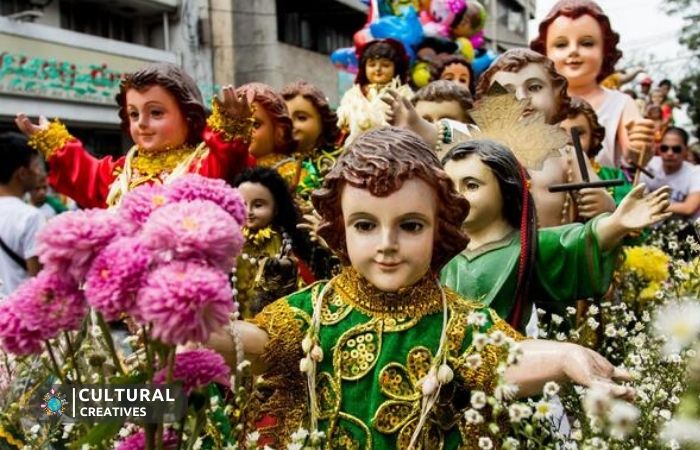
The Sto. Niño Festival isn’t just a feast for the eyes; it’s an auditory banquet that immerses participants in a world of rhythm and melody. Music is the heartbeat of this lively celebration, echoing the traditions and culture of its people. From the pulsating drumbeats to the soulful hymns, every note captures the spirit of devotion and jubilation unique to this iconic event. Prepare to be taken on a sonic journey through time-honored sounds and contemporary interpretations that define the auditory legacy.
Traditional Tunes And Rhythms
At the core of the Sto. Niño Festival, traditional tunes resonate with historical significance and cultural pride. The melodies, played on indigenous instruments like the gong and drum, have been passed down through generations. These rhythms form the soundtrack of the festivity where each beat tells a story of faith and tradition.
- Sinulog dance music – An essential element characterized by its distinctive rhythm.
- Folk hymns – Heartfelt songs expressing love and reverence for the Sto. Niño.
- Choral performances – Harmony-rich pieces that add a layer of spirituality to the air.
Rhythmic patterns bring energy and movement to the streets, making them alive with the sound of merriment that encourages participants to dance in synchronization with the reverent beats.
Modern Musical Interpretations
While tradition forms the foundation of the festival’s music, modern musical interpretations add a fresh twist, ensuring the event’s appeal to a wider, more contemporary audience. Bands and artists contribute their unique styles, blending traditional sounds with modern genres such as pop, rock, and electronic music.
- Pop renditions of hymns – Bringing a modern vibe to soul-stirring classics.
- Rock-infused performances – Adding an edge to traditional beats.
- Electronic remixes – Infusing the festival with an energetic pulse.
These contemporary sounds not only expand the musical repertoire of the festival but also engage and energize a crowd of all ages, creating an atmosphere that still honours the festival’s roots.
Culinary Delights: Tasting The Festival

As colors fill the streets and rhythmic drumbeats echo through the air, the Sto. Niño Festival also awakens the senses with its array of culinary offerings. This joyous occasion isn’t just a feast for the eyes and ears but also an indulgent journey for the palate. Explorers of traditional cuisine and lovers of street food alike will find this festival to be a gastronomic haven, representing the rich cultural tapestry of its origins.
Street Food And Local Delicacies
Strolling through the bustling lanes, visitors are greeted by an enticing variety of street food. Every corner offers a chance to savor local favorites:
- Isaw (Grilled chicken intestines) – A timeless street snack, rich in flavor and perfectly grilled to a smoky finish.
- Balut (Fertilized duck egg) – Daring palates are rewarded with bold textures and a robust taste unique to this delicacy.
- Bibingka (Rice cake) – Warm and soft, this rice cake infused with coconut milk is a sweet slice of festive tradition.
- Halo-halo (Mixed fruit dessert) – A delightful mix of crushed ice, fruits, and sweet beans topped with ice cream; essential for refreshing reprieves under the tropical sun.
These snacks are not just treats; they symbolize the communal spirit and shared heritage that the festival celebrates.
Feasting Traditions And Communal Meals
The festival’s beating heart lies in its feasting traditions — a testament to the community’s hospitality and unity. Long tables laden with food become the centerpieces of collective joy:
| Dish | Description | Significance |
|---|---|---|
| Lechon | A whole roasted pig, crispy-skinned and tender-fleshed, often the star at any feast. | Symbol of abundance and celebration. |
| Pancit | Various noodles sautéed with vegetables and meats, each type telling a different local story. | Represents long life and good health. |
| Adobo | Meat marinated in vinegar, soy sauce, and spices, known for its tangy-savory flavor. | An embodiment of Filipino culinary ingenuity. |
Dining collectively has always been an essential aspect of Filipino culture, especially during Sto. Niño. The communal meals are more than just eating together; they weave a tapestry of shared stories and laughter, reinforcing community ties and creating everlasting memories. So step up to the plate and dine as one in a culinary experience that nourishes both body and soul.
The Impact Of Local Communities

The Sto. Niño Festival is much more than a display of culture and faith—it stands as a pivotal force shaping the life and energy within local communities in the Philippines. Beyond the colorful parades and the rhythmic beats of the drums, the festival ignites a chain reaction of positive impacts within these communities, touching socio-economic growth and preserving age-old traditions that form the backbone of cultural identity.
Boosting Local Economy And Tourism
The Sto. Niño Festival consistently proves to be an economic powerhouse for local communities. At its core, the festival stimulates business as it:
- Attracts tourists from across the globe, eager to witness the spectacle.
- Encourages an influx of consumer spending on local services and products.
- Creates job opportunities in sectors such as hospitality, transportation, and retail.
Every year, hotels book up fast, restaurants bustle with patrons, and streets fill with vendors. With a surge in demand, entrepreneurs find innovative ways to cater to the needs of festival-goers, often leading to long-term business growth and entrepreneurial ventures.
Community Bonding And Cultural Identity
Community solidarity and the fortification of cultural identity are at the heart of the Sto. Niño Festival. By engaging in age-old traditions, locals:
- Forge stronger community bonds through collective celebration and worship.
- Celebrate and propagate their rich cultural heritage to younger generations.
- Experience a sense of unity and pride that reinforce communal ties.
Festival activities, such as dances and processions, act as communal rituals that reaffirm shared values and collective history. These events not only strengthen familial and neighborly relationships but also inspire a communal spirit that galvanizes residents to collaborate for common goals, thus fostering a more resilient and community.
Visual And Performance
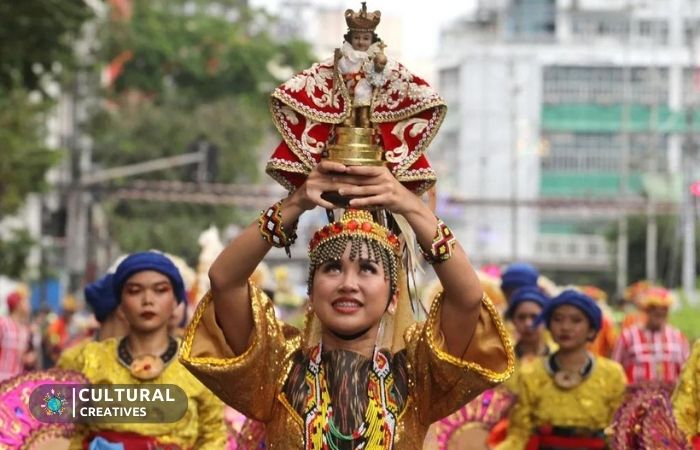
A kaleidoscope of color, faith, and culture, the Sto. Niño Festival sparkles not just as a religious celebration, but also as a showcase of artistic expression. This festival, revering the Child Jesus or Sto. Niño, ignites the creativity of artisans and performers, weaving together a tapestry of visual and performance arts that captures the essence of this illustrious occasion. From the streets that ripple with life to the stages that echo with storied performances, the festival is a nexus of Filipino heritage and artistic fervor.
Crafts And Artistic Creations
At the heart of the festival, handicrafts and artistic creations abound as tokens of devotion and ingenuity. Here is a glimpse into these treasured offerings:
- Sto. Niño Statuettes – Intricately carved and lovingly painted, these figurines are both worshipful icons and masterful works of art.
- Festival Garb – Vivid costumes, festooned with sequins and feathers, turn participants into living canvases, portraying stories and traditions through attire.
- Parade Floats – Flamboyant and majestic, the floats that glide through the streets are spectacular constructions that blend carpentry, painting, and floral art.
Artisans pour their passion into every detail, crafting pieces that capture the spirit of the Sto. Niño Festival for both onlookers and devotees.
Theatrical Plays And Dance Dramas
Theatrical plays and dance dramas form a dynamic aspect of the festival, showcasing tales of history, faith, and community. Spectacular performances include:
- Moriones – Masked performers embodying Roman soldiers reenact scenes from biblical tales.
- Sinulog Dance – Dancers move to the beat of drums, dramatizing the pagans’ conversion to Christianity.
- Passion Plays – Captivating reenactments of the life and miracles of Jesus Christ mesmerize audiences with a blend of drama and devotion.
These performances are not mere entertainment; they are powerful narratives that bond communities and breathe life into the festival’s historical roots.
Preserving Tradition: Efforts To Maintain Cultural Heritage

The Sto. Niño Festival is not just a spectacle of color and dance but a profound expression of cultural heritage that spans centuries. With the modern world rapidly transforming traditions, preserving these cultural practices is paramount. Engaging educational institutions, cultural societies, and receiving government support play key roles in maintaining the rich traditions of the festival for future generations.
Role Of Educational Institutions And Cultural Societies
Education is a powerful tool in sustaining cultural heritage. Schools and universities integrate the history and significance of the Sto. Niño Festival into their curriculum. This approach ensures that students understand and appreciate the festival’s roots, values, and its role in our shared identity.
Cultural societies work tirelessly to:
- Organize workshops and events that showcase traditional dances and crafts.
- Promote awareness about the cultural significance of the festival through various media.
- Engage the community in discussions about the preservation of our cultural practices.
These organizations often collaborate to host cultural exchange programs, bringing the essence of the Sto. Niño Festival to a wider audience and fostering a global appreciation for the tradition.
Government Support And Recognition
The government offers indispensable support for preserving cultural heritage. Official recognition of the Sto. Niño Festival as an invaluable cultural asset ensures protection and promotion. Government initiatives include:
| Funding Programs | Cultural Preservation Projects | Publicity Campaigns |
|---|---|---|
| Allocating resources for festival activities and conservation of historical artifacts. | Supporting restoration projects and maintenance of cultural landmarks linked to the Festival. | Utilizing media outlets to spread knowledge and involvement opportunities for all citizens. |
Legal frameworks also protect the festival’s intellectual property rights, safeguarding the community’s interests and heritage from commercial exploitation. Furthermore, the government collaborates with local leaders to ensure that the festival retains its authenticity while adapting to contemporary times.
Role And Relevance In Contemporary Society
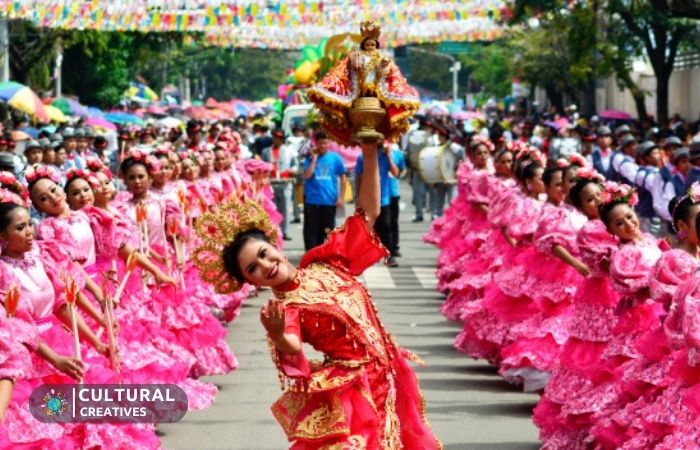
The Sto. Niño Festival in the Philippines is not just an explosion of color and energy, but also a critical anchor of cultural identity in the whirlwind of globalization. Every year, streets come alive with processions, dances, and music in honor of the Child Jesus (Sto. Niño). This festival is a melting pot of faith, tradition, and community, serving as a steadfast reminder of the enduring spirit of Filipino culture amidst the rapid changes of modern society.
Addressing The Challenges Of Modernization
As the world hurtles towards an increasingly digital future, the festival stands as a bastion against the homogenizing effects of modernization. Engaging with this festival allows for the reinvigoration of community values and provides a space for people to reconnect with their cultural roots.
- Safeguarding traditions against the backdrop of urbanization
- Adapting festivities to incorporate modern elements without losing essence
- Promoting inter-generational exchange as elders pass down knowledge to youth
By balancing reverence for history with present-day sensibilities, the festival continues to be relevant for Filipinos across the globe, reinforcing a sense of unity and identity.
Festival As A Platform For Social Issues And Advocacies
The festival transcends its religious origins, emerging as an influential platform for addressing social issues and promoting advocacies. It’s a stage where voices for change can echo amidst the festivities.
- Nutshell of various pressing concerns
| Advocacy | Description |
|---|---|
| Environmental Awareness | Heightened emphasis on eco-friendly practices and conservation campaigns during festival activities. |
| Community Outreach | Integration of charitable events targeting local development and support for the underprivileged. |
| Cultural Preservation | Proactive measures to document and promote the intangible heritage embedded in the festival’s traditions. |
- Strengthening community bonds through collective support for these causes.
In embodying such advocacies, the festival ignites discussions and focuses attention on societal growth, anchoring itself more firmly into the fabric of current national and global conversations.
Conclusion
As the Sto. Niño Festival wraps up, it leaves us with memories and the collective joy of honoring a cherished tradition. This remarkable celebration, steeped in faith and culture, beckons visitors from across the globe. Let’s carry its spirit of unity and festivity until next year—when jubilant streets come alive once again.




